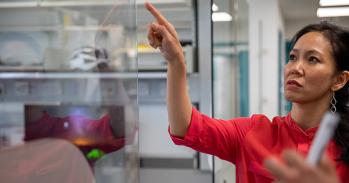
Scientists have located a region of DNA which – when altered – can increase the risk of ovarian cancer, according to research published in Nature Genetics over the weekend.
Scientists have located a region of DNA which – when altered – can increase the risk of ovarian cancer, according to research published in Nature Genetics over the weekend.
It is likely that the remaining risk is due to a combination of several unidentified genes - which individually carry a low to moderate risk. Now we have ticked one off, the hunt is on to find the rest.
Paul Pharoah
An international research group led by scientists based at the Cancer Research UK Genetic Epidemiology Unit at the University of Cambridge and UCL (University College London) searched through the genomes of 1,810 women with ovarian cancer and 2,535 women without the disease from across the UK. They analysed 2.5 million variations in DNA base pairs - the letters which spell out the genetic code - to identify common spelling 'errors' linked to ovarian cancer risk.
The scientists identified the genetic 'letters'- called single nucleotide polymorphisms (SNPs) - which when spelt slightly differently increase ovarian cancer risk in some women. This is the first time scientists have found a SNP linked uniquely to risk of ovarian cancer and is the result of eight years of investigations. With the help of the international Ovarian Cancer Association Consortium (OCAC), they then looked at more than 7,000 additional women with ovarian cancer and 10,000 women without disease from around the world to confirm this finding.
The region of risk DNA is located on chromosome nine (there are 23 pairs of each chromosome in humans, one of each pair inherited from each parent). The scientists estimate that there is a 40 per cent increase in lifetime risk for women carrying the DNA variation on both copies of chromosome nine compared with someone who doesn't carry it on either chromosome. The risk for women carrying the variation on both chromosomes is 14 in 1000 - compared with ten in 1000.
Approximately 15 per cent of women in the UK population carry two copies of the variant DNA.
The lifetime risk for a woman carrying the DNA variant on one copy of the chromosome is increased by 20 per cent from ten in 1000 to 12 in 1000. Approximately 40 per cent of women in the UK carry one copy.
Lead author, Professor Dr Paul Pharoah, a Cancer Research UK senior research fellow at the University of Cambridge, said: "We already know that people with mistakes in the BRCA1 and BRAC2 genes have a greater risk of ovarian cancer - but on their own they don't account for all of the inherited risk of the disease.
"It is likely that the remaining risk is due to a combination of several unidentified genes - which individually carry a low to moderate risk. Now we have ticked one off, the hunt is on to find the rest."
Senior author Dr Simon Gayther, whose work is supported by Cancer Research UK and The Eve Appeal charity which fundraises for the gynaecological cancer research team based at UCL, said: "The human DNA blueprint contains more than 10 million genetic variants. These are part and parcel of our characteristics and make-up - but a handful will also increase the chances of some women getting ovarian cancer and we have found the first one of these.
"There is now a genuine hope that as we find more, we can start to identify the women at greatest risk and this could help doctors to diagnose the disease earlier when treatment has a better chance of being successful."
Ovarian cancer is the fifth most common cancer in women in the UK with around 6,800 new cases diagnosed each year in the UK - 130 women every week. It is the fourth most common cause of cancer death in women in the UK with around 4,300 deaths from the disease in the UK each year.
BRCA1 and BRCA2 are high risk genes which cause breast cancer and are already known to significantly increase the risk of ovarian cancer but faults in these genes are rare and probably cause less than five per cent of all cases of ovarian cancer.
This work is licensed under a Creative Commons Licence. If you use this content on your site please link back to this page.





